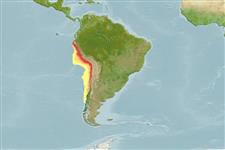Environment: milieu / climate zone / depth range / distribution range
Écologie
marin; océanodrome; profondeur 3 - 80 m. Subtropical; 13°C - 23°C (Ref. 6); 5°S - 43°S, 82°W - 69°W (Ref. 54434)
Southeast Pacific: Aguja Point, Peru to Chiloé, Chile (distribution dependent on the coastal extent of the Peru Current).
Length at first maturity / Taille / Poids / Âge
Maturity: Lm 12.0, range 10 - 12.5 cm
Max length : 20.0 cm SL mâle / non sexé; (Ref. 189); common length : 14.0 cm TL mâle / non sexé; (Ref. 5504); âge max. reporté: 3.00 années (Ref. 189)
Épines dorsales (Total): 0; Épines anales 0. Body elongate, slender, and rounded in cross section; snout long and prominent; lower branch of first gill arch with 34 to 49 gill rakers; anal fin with fewer than 22 rays, located behind dorsal fin base; body shiny blue or green (Ref. 55763). There is a silver stripe along flank in juveniles which disappears with age. The high number of gill rakers distinguishes it from all Pacific species of Anchoa.
Adults occur mainly within 80 km of coast, forming huge schools, chiefly in surface waters. Are filter-feeders entirely dependent on the rich plankton of the Peruvian Current. In some studies, diatoms constituted as much as 98% of the diet. Large populations of guano birds and pelicans also depend on this fish (Ref. 9988). Utilized as fish meal and oil (Ref. 9988).
Eggs ellipsoidal.
Whitehead, P.J.P., G.J. Nelson and T. Wongratana, 1988. FAO Species Catalogue. Vol. 7. Clupeoid fishes of the world (Suborder Clupeoidei). An annotated and illustrated catalogue of the herrings, sardines, pilchards, sprats, shads, anchovies and wolf-herrings. FAO Fish. Synop. 125(7/2):305-579. Rome: FAO. (Ref. 189)
Statut dans la liste rouge de l'IUCN (Ref. 130435)
Menace pour l'homme
Harmless
Utilisations par l'homme
Pêcheries: hautement commercial
Outils
Articles particuliers
Télécharger en XML
Sources Internet
Estimates based on models
Preferred temperature (Ref.
123201): 17 - 20.8, mean 19.7 °C (based on 10 cells).
Phylogenetic diversity index (Ref.
82804): PD
50 = 0.5020 [Uniqueness, from 0.5 = low to 2.0 = high].
Bayesian length-weight: a=0.00457 (0.00364 - 0.00574), b=3.12 (3.08 - 3.16), in cm total length, based on LWR estimates for this species (Ref.
93245).
Niveau trophique (Ref.
69278): 2.9 ±0.38 se; based on food items.
Generation time: 1.3 (1.1 - 1.3) years. Estimated as median ln(3)/K based on 60
growth studies.
Résilience (Ref.
120179): Haut, temps minimum de doublement de population inférieur à 15 mois (K=0.6-0.9; tm=1; tmax=3; batch fecundity > 10,000).
Prior r = 0.83, 95% CL = 0.55 - 1.25, Based on 4 stock assessments.
Fishing Vulnerability (Ref.
59153): Low vulnerability (17 of 100).
Climate Vulnerability (Ref.
125649): Moderate vulnerability (42 of 100).
Nutrients (Ref.
124155): Calcium = 233 [104, 574] mg/100g; Iron = 1.55 [0.73, 3.65] mg/100g; Protein = 18.7 [17.4, 20.0] %; Omega3 = 0.764 [0.444, 1.331] g/100g; Selenium = 16.8 [7.9, 39.6] μg/100g; VitaminA = 11 [2, 47] μg/100g; Zinc = 1.18 [0.73, 1.89] mg/100g (wet weight);
